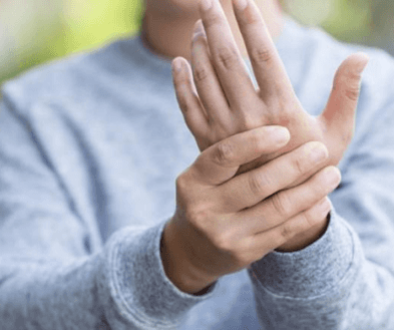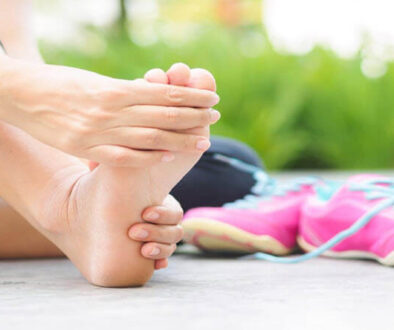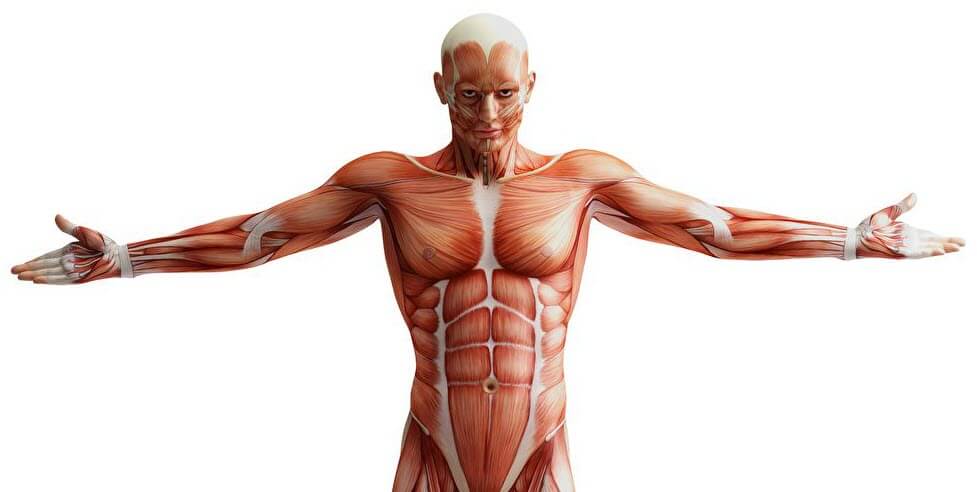
Soft Tissue WHAT is it? WHY does it matter?
What is Soft Tissue?
Soft tissue generally refers to tissues that support, connect and surround other structures and organs in the human body.
👉 Muscles & Tendons
👉 Ligaments & Joint Capsules
👉 Fascia
👉 Nerves
These tissues play the supporting role to the structural components, the bones, joint, cartilage, discs, etc. If soft tissues become injured and dysfunctional, that problem then transfers to the structure it supports, causing excessive wear and tear over time.
You can’t have a healthy joint, without healthy soft tissues surrounding it.
Acute soft tissue injury occurs when there is a known incident, like a sporting injury or another event that causes a painful sprain or strain. What we see more commonly however is chronic soft tissue injury. where the tissue has developed dysfunction over time via repetitive micro-trauma and sustained contractions (postural overload) causing a lack of blood flow.
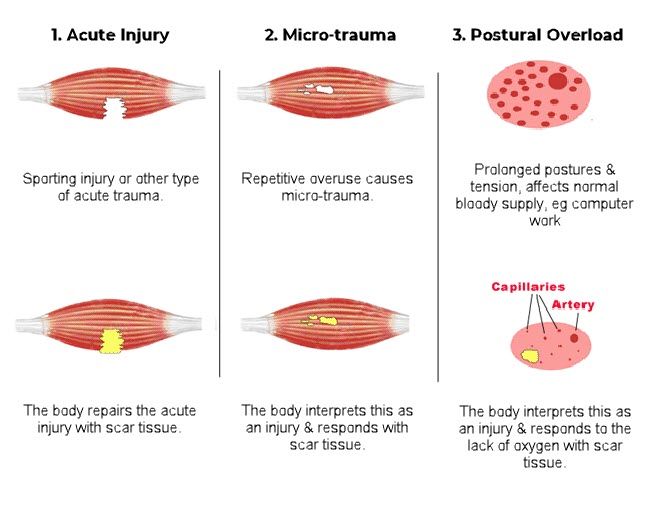
Micro-trauma: the consequence of being human
The soft tissues of the human body are subjected to various levels of stress and strain over time. We are constantly using our muscles, tendons, joint capsules, ligaments and nerves to accomplish daily tasks.
Over time, the stress and strain accumulates due to factors such as repetitive overuse, lack of strength and mobility, or just a constant low-level overload.
Micro-trauma is the result of the constant stress and strain within the soft tissues. In most cases, this micro-trauma is not painful as it occurs, but the human body still recognizes that the damage needs to be repaired. In attempt to repair the area, fibroblast cells respond by laying down small amounts of fibrous connective tissue (scar tissue).
Without intervention, this scar tissue will accumulate into what are called adhesions.
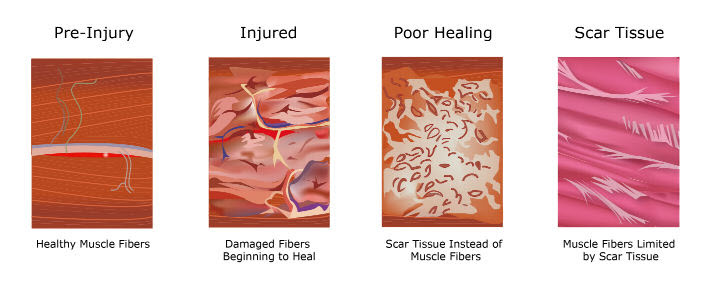
Scar tissue vs Adhesion vs Fibrosis
These terms are often used interchangeably and describe a similar problem that occurs within soft tissues – that is how the body responds to “injury” by laying down disorganised collagen fibers. Scar tissue is most often referred to as the result of healing that you see on the skin, when there has been a cut or another trauma that has healed. This is easy to diagnose – because you can see it! Adhesion is more difficult to diagnose because it’s not visible at the surface in the same way that a scar is. The adhesion causes chronic problems – things get tight, short and weak; or stuck together.
Soft tissues need to be able to glide and slide against each other. Muscles, tendons, ligaments, joint capsules, fascia and nerves – all need to be able to lengthen and contract for normal strength and function of a joint.
👉 When adhesions form, the soft tissue fibers get stuck together, like someone poured glue in there!
As these adhesions develop, they start to affect the normal health and function of the muscles, joints and nerves, leading to problems such as pain, tightness, stiffness and limited movement. This places additional strain on the affected tissues and joints, leading to further micro-trauma and a cycle that results in progressive dysfunction and symptoms.
It’s a common problem, although uncommonly treated
Scar tissue and the resulting adhesions are common, although it is often dismissed, or just totally unrecognised. Our methods have a history of success in dealing with many types of chronic problems, because we diagnose and treat the adhesion that leads to chronic pain.
⚠️ Muscle and joint pain
⚠️ Movement restriction
⚠️ Disc injuries
⚠️ Nerve pain (nerve entrapment)
These are often the resulting injury due to soft tissue adhesions that have gone unchecked over time. By firstly addressing the soft tissue component, we can unload the injury and lay the foundation for your joints to become healthier for the long-term, with added strength and stability.
Soft tissue health is a BIG DEAL
Healthy soft tissue is a pre-requisite for normal, pain-free movement. Joints and discs don’t like to be compressed and sheared beyond what is normal, yet this is what can result when our range of motion is poor and we don’t address the problem.
👉 Think of range of motion as being like blood pressure.
Just like if you had high blood pressure for long enough you are risking heart damage, having poor range of motion for long enough is increasing
the likelihood of musculoskeletal damage.
If you’ve had chronic pain or symptoms for several weeks or months, with little to no relief despite everything you’ve tried so far, please consider seeking out a provider with experience in assessment and treatment of nerve entrapments.
Dr. Christopher Aysom, Principal Clinician
BChiroSc, MChiro (Chiropractor)
Apex Soft Tissue & Spine
Pymble, NSW, Australia
https://apexsofttissue.com.au

